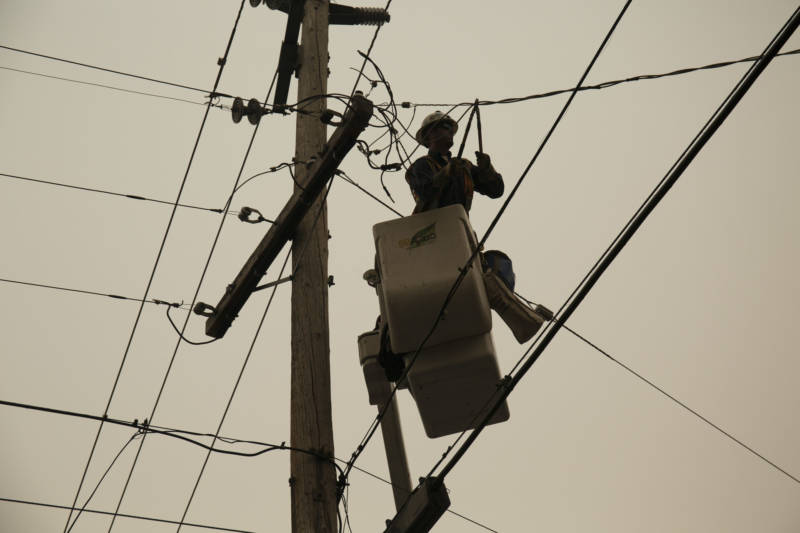Steven Greenlee, a Cal ISO spokesman, said PG&E could include turning off such lines in its public safety power shut-off program if it wanted.
"A transmission line is relatively easy to de-energize," Greenlee said. The company does not need to get permission from Cal ISO to shut down such a line; it just needs to let the grid managers know about it.
Greenlee said Cal ISO prefers to learn about a line shutdown in advance. "But they could, if needed, de-energize a line and then make a notification," he wrote in an email.
The California Public Utilities Commission, the state utility regulator, allows companies to turn off their lines as long as they tell their customers in advance and then submit reports to the state regulator about the shut-offs in the next 10 business days.
After repeated questions from KQED, PG&E representatives failed to say whether they would consider changing their shut-off programs to include higher-voltage transmission lines.
The Camp Fire started after a series of PG&E advisories, warning customers it might shut off power in parts of Butte County — and other parts of its Northern California coverage area — because of extreme fire danger due to high winds, low humidity and dry vegetation.
Those advisories were canceled and PG&E did not shut off the power because "weather conditions did not warrant this safety measure," the utility explained in a report last week.
PG&E said that even if it had pre-emptively turned the electricity off to prevent wildfires, it would not have included higher-voltage lines like the Caribou-Palermo one in its shut-off program.
"In light of the potential public safety issues resulting from de-energizing higher voltage transmission lines, including the potential to impact millions of people and create larger system stability for the grid, PG&E has not extended the program to transmission lines that operate at 115kV or above," company spokeswoman Deanna Contreras said in an email.
Greenlee said that Cal ISO can handle such a move.
"This is a practice we perform every day with scheduled work and unplanned outages," he said.
Powering down a high-voltage transmission line could take electricity away from a large section of the company's customers, PG&E has maintained. But the company declined to say how many customers would lose electricity if it turned down the Caribou-Palermo line.
"Due to security reasons, PG&E doesn't provide this level of detail about its electric system," said company spokeswoman Andrea Menniti.
The move could also increase the overall cost of energy, according to one leading electricity grid expert.
"You can de-energize a transmission line but that likely will have much broader effects across the entire network," said Alexandra von Meier, the director of electrical grid research at UC Berkeley's California Institute for Energy and Environment.
Transmission lines are interconnected in a utility's electricity network and shutting down one could affect others, Meier said. If PG&E were to turn one off, Cal ISO would need to figure out quick ways to replace the energy the turned-off line normally provides.
"It's a much more involved and complicated decision where there are more customers who may be impacted," Meier said, adding that the move could impact the price of electricity while the line is down.
Hours after the Camp Fire started, the utility told the California Public Utilities Commission that a power outage took place on the Caribou-Palermo line 14 minutes before the approximate time the blaze began. Cal Fire crews arriving on the scene reported seeing vegetation burning "on the west side of the river underneath the transmission lines."
Cal Fire identified a separate location as a potential second origin of the fire.
On Friday PG&E told the commission of a second outage on its equipment in the early moments of the fire. This time its 12-kilovolt Big Bend 1101 Circuit experienced an outage minutes after the blaze started, in Concow, a small unincorporated community east of Paradise.
The Big Bend circuit is a distribution line. Unlike the Caribou-Palermo line, it would have been de-energized if PG&E had pre-emptively shut off power, according to company spokeswoman Megan McFarland.
Read KQED's ongoing wildfire coverage.
